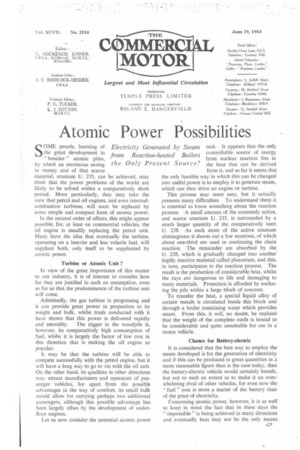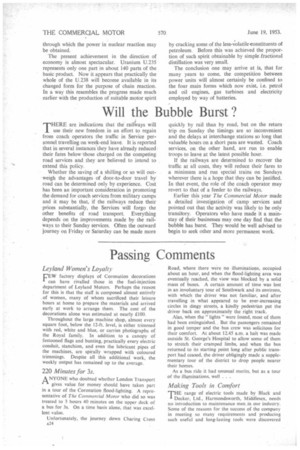Atomic Power Possibilities
Page 25

Page 26

If you've noticed an error in this article please click here to report it so we can fix it.
SOME people, learning of the great development in " breeder " atomic piles, by which an enormous saving in money and of that scarce material, uranium U. 235, can be achieved, may think that the power problems of the world are likely to be solved within a comparatively short period. More particularly, they may take the view that petrol and oil engines, and even internalcombustion turbines, will soon be replaced by some simple and compact form of atomic power.
In the natural order of affairs, this might appear possible, for, at least on commercial vehicles, the oil engine is steadily replacing the petrol unit. Many have the idea that eventually the turbine, operating on a heavier and less volatile fuel, will supplant both, only itself to be supplanted by atomic power.
Turbine or Atomic Unit ?
In view of the great importance of this matter to our industry, it is of interest to consider how far they are justified in such an assumption, even so far as that the predominance of the turbine unit will come.
Admittedly, the gas turbine is progressing and it can provide great power in proportion to its weight and bulk, whilst trials conducted with it have shown that this power is delivered rapidly and smoothly. The nigger in the woodpile is, however, its comparatively high consumption of fuel, whilst it is largely the factor of low cost in this direction that is making the oil engine so popular.
It may be that the turbine will be able to compete successfully with the petrol engine, but it will have a long way to go to vie with the oil unit. On the other hand, its qualities in other directions may attract manufacturers and operators of passenger vehicles, for apart from the possible advantages in the way of comfort, its small bulk would allow for carrying perhaps two additional passengers, although this possible advantage has been largely offset by the development of underfloor engines.
Let us now consider the potential atomic power unit. It appears that the only controllable source of energy from nuclear reaction lies in the heat that can be derived from it, and so far it seems that the only feasible way in which this can be changed into useful power is to employ it to generate steam, which can then drive an engine or turbine.
This process may seem easy, but it actually presents many difficulties. To understand them it is essential to know something about the reaction process. A small amount of the extremely active, and scarce uranium U. 235, is surrounded by a much larger quantity of the comparatively inert U. 238. As each atom of the active uranium disintegrates it shoots out a few neutrons, of which about one-third are used in continuing the chain reaction. The remainder are absorbed by the U. 238, which is gradually changed into another highly reactive material called plutonium, and this, in turn, participates in the reaction process. The result is the production of considerable heat, whilst the rays are dangerous to life and damaging to many materials. Protection is afforded by enclosing the pile within a large block of concrete.
To transfer the heat, a special liquid alloy of certain metals is circulated inside this block and through a boiler containing water which provides steam_ From this, it will, no doubt, be realized that the weight of the complete outfit is bound to be considerable and quite unsuitable for use in a motor vehicle.
Chance for Battery-electric It is considered that the best way to employ the steam developed is for the generation of electricity and if this can be produced in great quantities at a more reasonable figure than is the case today, then the battery-electric vehicle would certainly benefit, but not to such an extent as to make it an overwhelming rival of other vehicles, for even now the " fuel " cost is more a matter of the battery than of the price of electricity.
Concerning atomic power, however, it is as well to keep in mind the fact that in these days the " impossible " is being achieved in many directions and eventually heat may not be the only means through which the power in nuclear reaction may be obtained.
The present achievement in the direction of economy is almost spectacular. Uranium U.235 represents only one part in about 140 parts of the basic product. Now it appears that practically the whole of the U.238 will become available in its changed form for the purpose of chain reaction. In a way this resembles the progress made much earlier with the production of suitable motor spirit by cracking some of the less-volatile constituents of petroleum. Before this was achieved the proportion of such spirit obtainable by simple fractional distillation was very small.
The conclusion one may arrive at is, that for many years to come, the competition between power units will almost certainly be confined to the four main forms which now exist, i.e. petrol and oil engines, gas turbines and electricity employed by way of batteries.




















































































